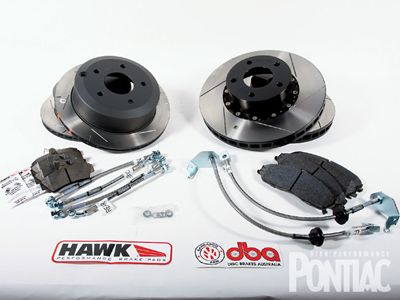
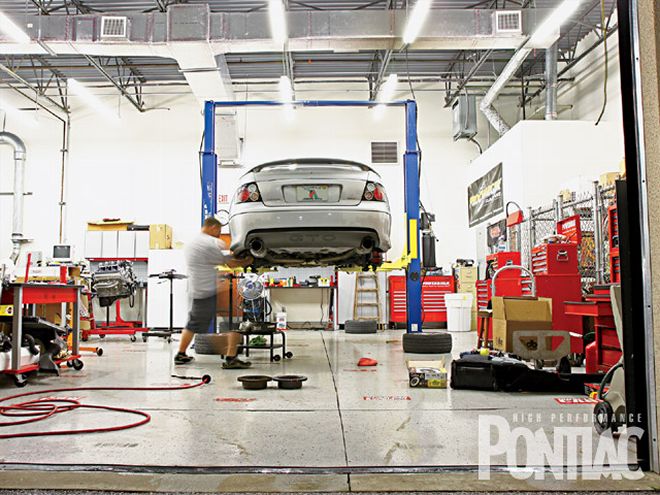
Part I: The Products and the Front Brake Install
In 2004 the all-new GTO was brought to American shores from Australia. The nearly 3,800-pound Goat was stopped by two-piston floating calipers clenching 11.7-inch ventilated front rotors, and the 11.3-inch rears were squeezed by single-piston units. With reviews on style aside, media coverage agreed upon one thing, the brakes could be better. Pontiac made many improvements to the GTO for the 2005 model year, and the brakes were one of them.
The new, larger 12.6-inch front rotors now featured calipers from the Corvette and were painted red with white "GTO" letters. The rears were upgraded to ventilated discs to improve cooling through the rotor surface. While braking performance was better for the LS2-powered Goats, there was still room for improvement.
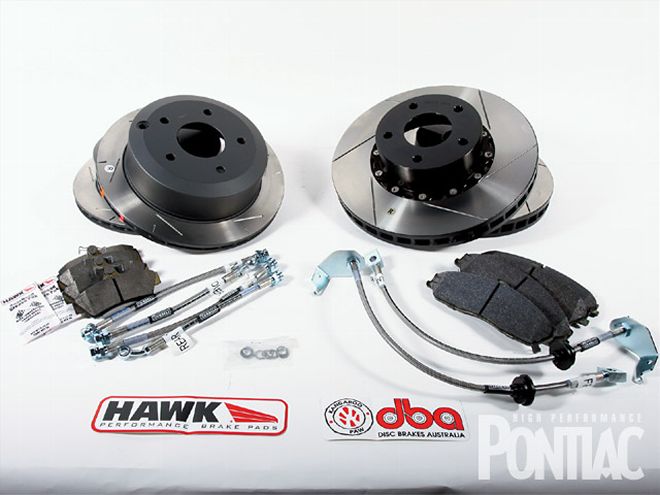 In an effort to improve our GTO's braking without breaking the bank, we upgraded to DBA 5000- and 4000-series rotors with Hawk HPS pads and Russell stainless lines. The DBA front rotors are PNs 52020BLKSL and 52020BLKSR and retail for $1,056 per pair. They are only sold in pairs. Rear DBA rotors under PNs 42021SL and 42021SR cost $165 each or $330 per pair. The Russell lines (PN RUS692320) added $140 to the cost. Hawk HPS brake pads (front PN HB247F.575, rear PN HB573F.615) cost $70 and $90, respectively.
In an effort to improve our GTO's braking without breaking the bank, we upgraded to DBA 5000- and 4000-series rotors with Hawk HPS pads and Russell stainless lines. The DBA front rotors are PNs 52020BLKSL and 52020BLKSR and retail for $1,056 per pair. They are only sold in pairs. Rear DBA rotors under PNs 42021SL and 42021SR cost $165 each or $330 per pair. The Russell lines (PN RUS692320) added $140 to the cost. Hawk HPS brake pads (front PN HB247F.575, rear PN HB573F.615) cost $70 and $90, respectively.
Our 2005 Pontiac GTO had warped rotors that were becoming a chore to drive and race with and its autocross sessions had certainly taken their toll. We decided to have them resurfaced, and though they were still well within spec, doing this makes them more susceptible to warping again and we started to feel some pulsated return within a couple of months. Resurfacing or "turning" a rotor reduces the amount of rotor material, therefore affecting thermal properties.
For baseline testing, the rotors were replaced with another set that were trued and were well within thickness spec. The pads were also checked to ensure that they had enough meat on them to still work properly.
Since the setup was stopping our GTO well, we decided to make upgrades to the existing hardware, instead of opting for an expensive big brake kit. With a little research, one name consistently came up, Disc Brakes Australia (DBA). Widely popular Down Under, it's become a leader in GTO rotor upgrades stateside. All of the company's rotors feature a unique-vane design it calls "Kangaroo Paw" technology. DBA claims that they run cooler, are stronger, and outperform traditional straight-vane disc rotors by up to 20 percent.
During a discussion with Mark Joseph at DBA, we found our brake setup. The fronts would be replaced with the DBA 5000-series and the rears with the 4000-series.
The 5000-series rotors are two-piece and feature an aircraft-grade aluminum center hat that provides greater resistance to distortion, as it allows the disc to expand uniformly. In addition to the improved thermal properties, they are also considerably lighter than traditional rotors, by approximately 6 pounds in our application. This may not seem like a great deal, but consider that this is unsprung weight which is rotating with the wheel and suspension.
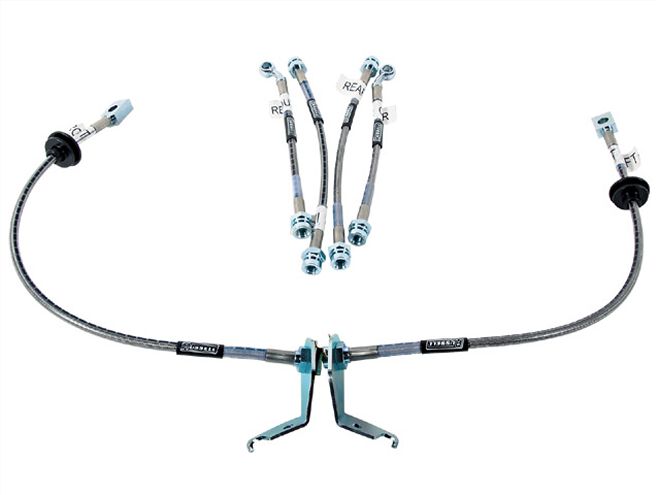 Russell's stainless brake lines are clearly marked to show where they are installed. The fronts are single-piece and the rears are two-piece.
Russell's stainless brake lines are clearly marked to show where they are installed. The fronts are single-piece and the rears are two-piece.
With the rotor selection handled, DBA highly recommended Hawk Performance brake pads. Its HPS street pads promise to greatly improve stopping power, yet produce low dust and are gentle on rotors. We always have the option of upgrading our pad material if we find the compound isn't sticky enough, but our testing has shown we should be good to go.
The final upgrades were the brake lines (hoses) and fluid. It's always a good practice to replace your brake fluid whenever you do a pad and rotor swap. We took the opportunity to use Amsoil Series 600 High Performance DOT4 brake fluid; it's one of the best out there and has an extremely high boiling point of 580 degrees Fahrenheit, considerably higher than any off-the-shelf fluid at your local parts store. We predict high temperatures on the track and don't want to risk a mushy pedal after only a few laps. Russell stainless steel brake lines were also installed. The factory rubber lines have a tendency to expand when super-heated fluid runs through them, further degrading pedal feel.
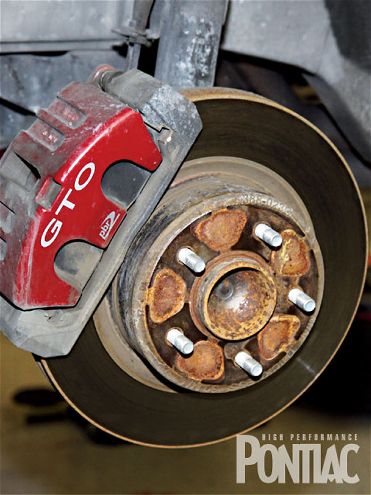 The factory brakes served our Goat for 55,000 miles before we had the 12.6-inch rotors resurfaced. By the time we were ready to begin the swap, the brake pulsation was beginning to come back.
The factory brakes served our Goat for 55,000 miles before we had the 12.6-inch rotors resurfaced. By the time we were ready to begin the swap, the brake pulsation was beginning to come back.
We had no trouble installing the brake parts and it's something you can do easily in your driveway in a day.
Once they were installed, we performed the proper bed-in procedure for the pads (we'll cover this in Part II) before we drove home in traffic. Our first impression was the new, great response from the brakes. They really bite now and made a large improvement at the autocross. There was no noticeable fade, even after repeated heavy stops around the track. The ABS system was kept in check and worked well at controlling the more powerful brakes.
Though easy to install, it took nearly 40 photos and captions to show the parts, the install, and the testing, so this story will be presented in two parts. We'll get into the descriptions and the install of the front brakes in Part I and finish up in Part II with the rear brakes and the testing.
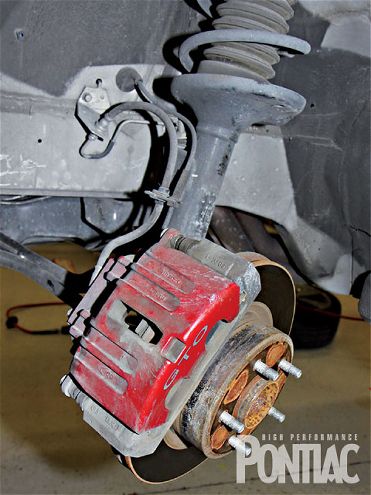 Note the black rubber-brake hose and the factory PBR two-piston caliper assembly.
Note the black rubber-brake hose and the factory PBR two-piston caliper assembly.
The Long Debate: Slotted Vs. Drilled Rotors
All over the internet and at every track, we're sure you've heard the debate about which is better: slotted or drilled. We were sure to bring this topic up with Mark Joseph and John Poulakis at DBA. When our brakes were suggested to us for our application, we weren't the least-bit surprised that they were slotted only.
According to John, slotted is best suited for heavy-duty conditions with high thermal loads. The slots clean the pad face while helping with the outgassing of the pads, and provide more even pad wear with reduced glazing. Drilled or drilled-and-slotted are best suited for improved braking performance under normal driving conditions. "They're not recommended for extreme conditions where there are high thermal loads," he says.
In high-heat conditions, drilled rotors tend to crack or "spider" around the holes. They also reduce the amount of surface area for the heat to dissipate, diminishing their cooling ability. Since our GTO will see heavy autocross and open-track time, it's safe to say that this is a heavy-duty role that will generate a lot of heat. We won't have to worry about any cracks forming and our pad surface will continually be cleaned.